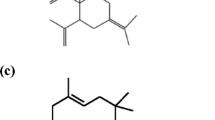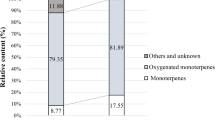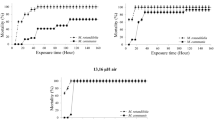Abstract
Lippia gracilis Schauer, Verbenaceae, is a plant popularly known as "Alecrim-da-Chapada" or “Alecrim-de-Serrote", characteristic of the savanna areas in North and Northeast Brazil. Its essential oil has been tested for pest control due to its bioactive potential. In this work, the chemical composition was analyzed and the insecticidal effect of the pinene/cineol/limonene chemotype leaf oil of L. gracilis, from Chapada das Mesas, Maranhão State, was tested against the armyworms Spodoptera frugiperda (Lepidoptera: Noctuidae). GC and GC-MS analysis identified α-pinene (24.5%), 1,8-cineole (16.2%), β-pinene (11.9%) and limonene (9.6%) as the main constituents of the oil, which presented a yield of 4.3%. For the insecticidal activity, the topical and surface contact tests were carried out with ten-days armyworm’s larvae (third instar), in different concentrations of oil and α-pinene, its main constituent. For the oil, the acute topical toxicity (LD50) was 0.09 μL/insect, and the contact surface toxicity (LC50) was 1.55 μL/cm2, while for α-pinene these values were (LD50) 0.28 μL/insect and (LC50) 2.50 μL/cm2, respectively. Thus, the oil was more active than α-pinene showing that the insecticide effect is due to the synergistic action of the mixture of its constituents. The results lead to the conclusion that the essential oil is promising as a sustainable tool in the management of S. frugiperda.
Similar content being viewed by others
References
Adams RP (2007) Identification of essential oil components by gas chromatography/mass spectrometry, fourth. Allured Publ Corp, Carol Stream
Bitu V, Botelho MA, da Costa JGM, Rodrigues FFG, Veras HNH, Martins KT, Lyra A, Coluchi GG, Ruela RS, Queiroz DB, Siqueira JS, Quintans-Junior LJ (2012) Phytochemical screening and antimicrobial activity of essential oil from Lippia gracilis. Braz J Pharmacogn 22:69–75
Born FS, da Camara CAG, de Melo JPR, de Moraes MM (2018) Acaricidal property of the essential oil from Lippia gracilis against Tetranychus urticae and a natural enemy, Neoseiulus californicus, under greenhouse conditions. Exp Appl Acarol 75:491–502
Cavalcanti SCH, Niculau ES, Blank EF, Câmara CAG, Araújo IN, Alves PB (2010) Composition and acaricidal activity of Lippia sidoides essential oil against two-spotted spider mite (Tetranychus urticae Koch). Bioresour Technol 101:829–832
Choi W-S, Park B-S, Lee Y-H, Jang DY, Yoon HY, Lee S-E (2006) Fumigant toxicity of essential oils and monoterpenes against Lycoriella mali adults. Crop Prot 25:398–401
Cruz EMO, Costa-Junior LM, Pinto JAO, Santos DA, de Araujo SA, Arrigoni-Blank MF, Bacci L, Alves PB, Cavalcanti SCH, Blank AF (2013) Acaricidal activity of Lippia gracilis essential oil and its major on the tick Rhipicephalus (Boophilus) microplus Vet Parasitol 195:198–202
Cruz GS, Wanderley-Teixeira V, da Silva LM, Dutra KA, Guedes CA, de Oliveira JV, Navarro DMAF, Araújo BC, Teixeira AAC (2017) Chemical composition and insecticidal activity of the essential oils of Foeniculum vulgare Mill., Ocimum basiculum L., O. gratissimum L., Eucalyptus staigeriana F. Muell. ex Bailey, and E. citriodora Hook and their major components on Spodoptera frugiperda (Lepdoptera: Noctuidae). J Essenttial Oil Bearing Plants 20:1360–1369
da Fonseca PRB, Mota TA, Kassab SO, Fernandes MG (2012) Seletividade de inseticidas utilizados no controle da Spodoptera frugiperda (J.E. Smith, 1797) nos inimigos naturais epigéicos na cultura do milheto. Revista Catinga 25:14–19
de Melo JL, Bitencourt TA, Fachin AL, Cruz EMO, de Jesus HCR, Alves PB, Arrigoni-Blank MF, Franca SC, Beleboni RO, Fernandes RPM, Blank AF, Scher R (2013) Antidermatophytic and antileishmanial activities of essential oils from Lippia gracilis Schauer genotypes. Acta Trop 128:110–115
Faveiro S, Conte CO (2008) Métodos de ensaios para determinação de atividade insetistática de derivados de plantas com alternativa sustentável de controle de pragas agrícolas. In: Bauer FC, Vargas Junior FM (eds) Produção e Gestão agroindustrial, vol 2. UNIDERP, Campo Grande, pp 235–249
Ferraz RPC, Bonfim DS, Carvalho NC, Soares MBP, da Silva TB, Machado WJ, Prata APN, Costa EV, Moraes VRS, Nogueira PCL, Bezerra DP (2013) Cytotoxic effect of leaf essential oil of Lippia gracilis Schaer (Verbenaceae). Phytomedicine 20:615–621
Finney DJ (1971) Probit analysis, 3rd edn. Cambridge Press, London
Franco CS, Ribeiro AF, Carvalho NCC, Monteiro OS, da Silva JKR, Andrade EHA, Maia JGS (2014) Composition and antioxidant and antifungal activities of the essential oil from Lippia gracilis Schauer. Afr J Biotechnol 13:3107–3113
Gomes GA, Monteiro CMO, Julião LS, Maturano R, Senra TOS, Calmon ZV, Matos F, Daemon RS, de Carvalho E (2014) Acaricidal activity of essential oil from Lippia sidoides unengorged larvae and nymphs of Ripicephalus sanguineus (Acari: Ixodidae) and Amblyomma cajennense (Acari: Ixodidae). Exp Parasitol 137:41–45
Guilhon CC, Raymundo LJRP, Alviano DS, Blank AF, Arrigoni-Blank MF, Matheus ME, Cavalcanti SCH, Alviano CS, Fernandes PD (2011) Characterisation of the anti-inflammatory and antinociceptive activities and the mechanism of the action of Lippia gracilis essential oil. J Ehtnopharmacol 135:406–413
Isman MB (2006) Botanical insecticides, deterrents, and repellents in modern agriculture and an increasing regulated world. Ann Rev Entomol 51:45–66
Jiang ZL, Akhtar Y, Zang X, Bradbury R, Isman MB (2012) Insecticidal and feeding deterrent activities of essential oils in the cabbage looper, Trichoplusia ni (Lepdoptera: Noctuidae). J Appl Entomol 136:191–202
Karr LL, Coats JR (1988) Insecticidal properties of d-limonene. J Pest Sci 13:287–290
Khani A, Basavand F, Rakhshani E (2012) Chemical composition and insecticide activity of lemon verbena essential oil. J Crop Prot 1:313–320
Lima HRP, Kaplan MAC, Cruz AVM (2003) Influência dos fatores abióticos na produção e variabilidade de terpenóides em plantas. Floram (Floresta e Ambiente) 10:71–77
Lima RK, Cardoso MG, Moraes JC, Andrade MA, Melo BA, Rodrigues VG (2010) Caracterização química e atividade inseticida do óleo essencial de Ageratum conyzoides L. sobre a lagarta-do-cartucho do milho Spodoptera frugiperda (Smith 1797) (Lepdoptera: Noctuidae). Bioscience Journal 26:1–5
Lima RK, Cardoso MG, Moraes JC, Carvalho SM, Rodrigues VG, Guimarães LGL (2011) Chemical composition and fumigant efect of essential oil of Lippia sidoides Cham. and monoterpenes against Tenebrio molitor (L.) (Coleoptera: Tenebrionidae). Ciência e Agrotecnologia 35:664–671
Lorenzi H, Matos FJA (2001) Plantas Medicinais no Brasil: Nativas e exóticas. Nova Odessa, Plantarum
Melo CR, Picanço MC, Santos AA, Santos IB, Pimentel MF, Santos ACC, Blank AF, Araujo APA, Cristaldo PF, Bacci L (2018) Toxicity of essential oils of Lippia gracilis chemotypes and their major compounds on Diaphania hyalinata and non-target species. Crop Protetion 104:47–51
Mendes SS, Bonfim RR, Jesus HCR, Alves PB, Blank AF, Estevam CS, Antoniolli AR, Thomazzi SM (2010) Evaluation of the analgesic and anti-inflammatory effect the essential oil of Lippia gracilis leaves. J Ethnopharmacol 129:391–397
Mondello L (2011) Flavors and fragrances of natural and synthetic compounds, Mass Spectral Database (FFNSC 2). Wiley, New York
Montezano DG, Specht A, Sosa-Gómez DR, Roque-Specht VF, Sousa-Silva JC, Paula-Moraes SV, Peterson JA, Hunt TE (2018) Host-plants of Spodoptera frugiperda (Lepdoptera: Noctuidae) in the Americas. Afr Entomol 26:286–300
Negrini M, Fidelis EG, Schurt DA, Silva FS, Pereira RS, Bizzo HR (2018) Insecticidal activity of essential oils in controlling fall armyworm, Spodoptera frugiperda. Arq Inst Biol 86:1–9
Neto RM, Matos FJA, Andrade VS, de Melo MCN, Carvalho CBM, Guimarães SB, Pessoa ODL, Silva SL, Silva SFR, Vasconcelos PRL (2010) The essential oil from Lippia gracilis Schauer, Verbenaceae, in diabetic rats. Braz J Pharmacogn 20:261–266
Niculau ES, Alves PB, Nogueira PCL, Moraes VRS, Matos AP, Bernardo AR, Volante AC, Fernandes JB, da Silva MFGF, Corrêa AG, Blank AF, Silva AC, Ribeiro LP (2013) Atividade inseticida de óleos essenciais de Pelargonium graveolens l’Herit e Lippia alba (Mill) N.E. Brown sobre Spodoptera frugiperda (J.E. Smith). Quim Nova 36:1391–1394
NIST (National Institute of Standards and Technology) (2011) Mass spectral library (NIST/EPA/NIH, v.2.0d). The NIST Mass Spectrometry Data Center, Gaithersburg
O’Leary N, Denham SS, Salimena F, Múlgura ME (2012) Species delimitation in Lippia section Goniostachyum (Verbenaceae) using the phylogenetic species concept. Bot J Linn Soc 170:197–219
Panizzi AR, Parra JRP (2009) Bioecologia e nutrição de insetos: base para o manejo integrado de pragas. Embrapa, Brasília
Pascual ME, Slowing K, Carretero E, Sanchez Mata D, Villar A (2001) Lippia: traditional uses, chemistry and pharmacology: a review. J Ethnopharmacol 76:201,214
Pavela R, Benelli G (2016) Essential oils as ecofriendly biopesticides? Challenges and constraints. Trends Plant Sci 21:1000–1007
SAS Institute (2002) SAS/STAT User’s guide, version 8.02, TS level 2MO. SAS Institute Inc, Cary
Sigel E, Steimann ME (2012) Structure, function and modulation of GABAA receptors. J Biol Chem 287:40224–40231
Silva WJ, Dória GAA, Maia RT, Nunes RS, Carvalho GA, Blank AF, Alves PB, Marçal RM, Cavalcanti SCH (2008) Effects of essential oils on aedes aegypti: alternatives to environmentally safe insecticides. Bioresour Technol 99:3251–3255
Tak JH, Jovel E, Isman MB (2015) Comparative and synergistic activity of Rosmarinus officinalis L. essential oil constituents against the larvae and an ovarian cell line of the cabbage looper, Trichoplusia ni (Lepidoptera: Noctuidae). Pest Manag Sci 72:474–480
Teles TV, Bonfim RR, Alves PB, Blank EF, Jesus HCR, Quintans-Jr LJ, Serafini MR, Bonjardim LR, Araújo, A.A.S (2010) Composition and evaluation of the lethality of Lippia gracilis essential oil to adults of Biomphalaria glabrata and larvae of Artemia salina. Afr J Biotechnol 9:8800–8804
Terblanché FC, Kornelius G (1996) Essential oil constituents of the genus Lippia (Verbenaceae) - a literature review. J Essent Oil Res 8:471–485
Van Den Dool H, Kratz PDJA (1963) Generalization of the retention index system including linear temperature programmed gas-liquid partition chromatography. J Chromatogr A 11:463–471
Acknowledgements
The authors wish to thank CNPq, CAPES, Cogna Group (Kroton), and University of Anhaguera - Uniderp for financial support.
Author information
Authors and Affiliations
Corresponding author
Ethics declarations
Conflict of interest
The autors declare that they have no conflict of interest.
Rights and permissions
About this article
Cite this article
Monteiro, I.N., Ferreira, L.O.G., de Oliveira, A.K.M. et al. Toxicity of the Lippia gracilis essential oil chemotype, pinene-cineole-limonene, on Spodoptera frugiperda (Lepidoptera: Noctuidae). Int J Trop Insect Sci 41, 181–187 (2021). https://doi.org/10.1007/s42690-020-00191-y
Received:
Accepted:
Published:
Issue Date:
DOI: https://doi.org/10.1007/s42690-020-00191-y




